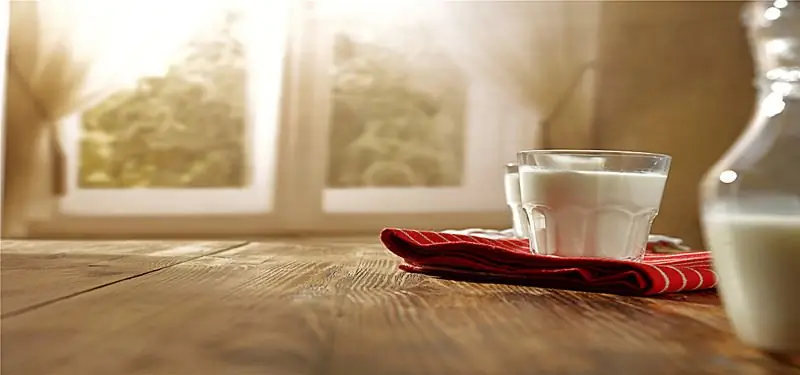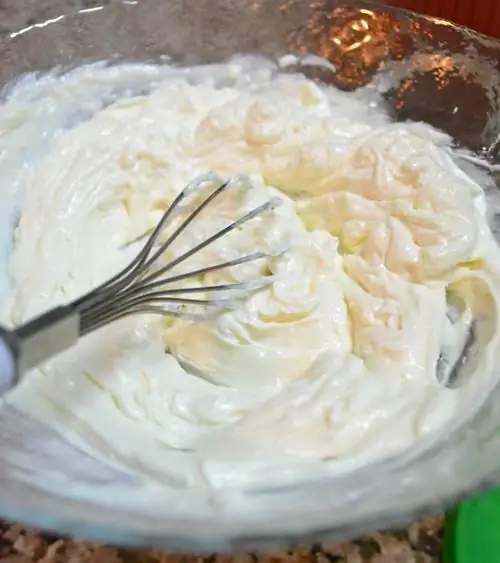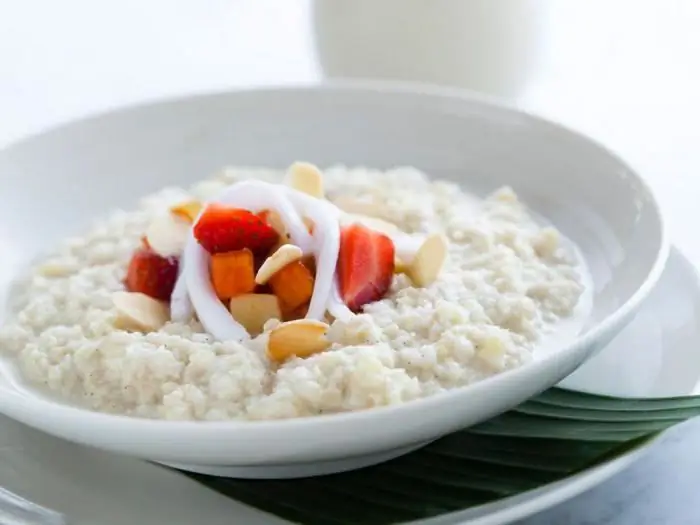2025 Author: Isabella Gilson | [email protected]. Last modified: 2025-01-23 12:50:36
Glaze is the main decoration of Easter cakes and Christmas gingerbread. Its composition is very simple, but everyone knows that making this delicious decoration is quite difficult. Our article is devoted to the intricacies of preparing milk glaze. If you listen to the tips below, then even when cooked for the first time, it will delight you with its excellent quality. In the first part of the article, we will tell you how the classic glaze is made. And we will devote the second part to a lighter version of decorative icing for baking.

What should be the icing
If you are going to make a classic glaze, be patient and have free time. This is a rather difficult matter. Much depends on the skill and intuition of the cook, because at each stage the consistency of the milk glaze is different. Actually, this is precisely the complexity of its manufacture.
The finished glaze should not crumble, break, be rough, too thick or transparent. Ideal dairyicing for a cake, Easter cake or gingerbread - white, smooth and shiny. Usually it is not prepared for the future, as it quickly hardens and its elasticity is not restored. This does not apply only to the first recipe.

Three types of consistency
For cakes and Easter cakes, milk icing is made more elastic and thick than for gingerbread. It should spread a little and stick well to the surface of the biscuit. Thick smudges are allowed on the sides of Easter cakes - this is an additional tasty decoration.
As for gingerbread, on which lace is painted with icing, it should be more liquid, because the thinner the lines, the more beautiful the product.
The third use of icing is to decorate gingerbread houses. In this case, it is tinted with food paints. It should not run off the structural elements, crack or be too thin or dense.
As you can see, milk icing is different. From the culinary specialist, a very measured approach is required, even a kind of flair. The only way to learn how to glaze desserts is through trial and error. Our recommendations have been repeatedly tested empirically by many chefs. We hope that they will help you in your culinary experiments and you will also cope with your task.

The secret to the right consistency
To understand how to make milk glaze viscous, homogeneous and white without adding milk or dye, you need to understand the technology. After all, icing is, in fact, sugar syrup, and, as you know, it tends tocrystallization, or candied. In industrial production, this property is combated by adding invert sugar syrup or molasses. At home, it is more convenient to use citric acid for these purposes. It is more expensive than molasses and invert syrup, but it retains the structure of sugar crystals much better. For home baking citric acid, you need very little, therefore, it will not be too burdensome for your wallet. It is added while the syrup is being boiled.
Sugar crystals in the glaze are very small, indistinguishable by eye - that's why the glaze looks tender and creamy.

Recipe 1 (classic)
250 g of granulated sugar and 30 g of lemon juice will take to prepare the glaze. Water is taken in proportion to sugar, as one to three. This is the minimum amount of water in which the sugar will completely dissolve. In our case, this is about 80-90 g. The ratio of ingredients is rather arbitrary - the readiness of lipstick is determined in the process of boiling the syrup and evaporating excess water. If it turns out to be too much, then it's better than too little - you just need to hold the syrup on the fire a little longer.

First stage
Take a non-enameled heavy-bottomed pot and pour sugar into it. Pour in water and put on a small fire. Stir until the sugar is completely dissolved.
Make the fire strong and bring the syrup to a boil. From time to time wipe sugar clots from the sides of the pan. It is convenient to do this with a silicone brush. If the clots are not washed, they will fall into the finished glaze, and the sugar will quickly crystallize into large fractions. In sugar production, it is with the help of ready-made sugar crystals added to syrup that they achieve the production of granulated sugar with crystals of the same size and shape.
Let the syrup boil for 4-5 minutes. Then add citric acid to it.

Second stage
Now it's time to determine the readiness of the syrup. Everything must be done very quickly and carefully. Firstly, because every extra second will affect the quality of the glaze, and secondly, because it is hot and sticky, you can get a serious burn.
The readiness check is defined as follows. You need to prepare a bowl of cold water in advance - you will lower a spoonful of syrup into it and check its softness. To do this, scoop up a third of a teaspoon of syrup and dip it in water for a few seconds. Remove immediately and remember carefully. If you managed to make a soft ball, immediately remove the syrup from the heat. He's ready. Now it's time for the next step.

Third stage
To make the resulting transparent syrup become a milky-white icing, it must be whipped. The matter is simple. The classic glaze is kneaded to a white cream by stretching it with a porcelain knife on a marble board.
Glaze is poured onto the board. Then the knife is raised, moved and lowered until it becomes uniformly white. This process is quite long. Atthe presence of a mixer and nozzles for whipping dough can be reduced several times.
To work with a mixer, you need to take two bowls of different sizes - put ice in a large one, and pour syrup into a small one. It is also desirable to pour large (chestnut-sized) pieces of ice on it. Whisk frosting with ice. It will melt and cool the glaze, but the water will not mix with it. You then just pour it out. Whipping with ice reduces the time it takes the syrup to glaze to 10-15 minutes, while stirring on a marble board lasts at least 40 minutes.
Determining the readiness of the glaze is very simple. This can be seen by the way the syrup changes its consistency and color. When it turns white, stops sticking and forms easily, like heated plasticine, the icing is ready. Wrap it in a wet cloth and put it in a plastic container. After a day, the glaze stabilizes, and it can be used - just warm it up a little in a water bath or near a warm battery. You can apply it either with a spatula, smearing the surface of the biscuit, or by placing it in a cornet, for squeezing out in the form of a thin thread and drawing.
The frosting made according to this recipe can be stored in the refrigerator for as long as you like.
Next - three more recipes. They are much simpler than the first, but in terms of taste and appearance they are in no way inferior to it.

Marshmallow
Easy and quick to make marshmallow icing. Unlike the classic one, the recipe of which is given above, it is not stored for a long time. It is appliedstraightaway. The main advantage of this glaze is that even a beginner can make it. It always turns out homogeneous, tender and plastic. It hardens on top, but remains moist and soft on the inside. For this reason, if the plans include a decorative topping of a cake or Easter cake, this must be done very quickly, until the icing has lost its stickiness. By the way, it is this milky icing for Easter cakes that is most suitable.
To prepare it, you need to take a 100-gram package of marshmallows, a tablespoon of butter, the same amount of lemon juice and from 120 to 150 g of powdered sugar. The secret of the excellent consistency of this glaze is precisely in the use of powdered sugar. Sand - no way! Instead of marshmallows, you can take marshmallows, but powder cannot be replaced with sugar. Its crunchy crystals will spoil the whole dessert. This glaze also cooks very quickly, so use a water bath to prevent it from burning.
Pour marshmallows into a small saucepan, add oil and citric acid. Dip this pot into a larger container of hot water. Put on fire. Stir. After the zafir has melted, start pouring in the powder. Stir all the time. Determine the density experimentally. Too liquid will run off the biscuit, and too thick will be difficult to apply.
Pour Easter cake with hot icing, sprinkle multi-colored dragees on top and leave to harden. After a couple of tens of minutes, the glaze will acquire, as they say, a presentation.

With creamy taste and vanilla aroma
Milky white icing with creamtaste can be obtained if you act according to the first recipe, but instead of water, take milk. Citric acid is not allowed, as it instantly curdles milk and no icing will work. Instead of acid, use molasses or glucose syrup. It will take a little longer to cook the glaze with them, but it is guaranteed not to crystallize. 50 g of butter added at the end of cooking will make the icing shiny, and vanillin fragrant. The readiness of the glaze can be checked as follows: drop a little glaze into a glass of cold water. If it falls to the bottom in the form of a thick cake, then it is ready. Apply it with a brush in several layers.

From chocolate bar
White milk chocolate icing is made after the cookie, cake or cake has already been baked and cooled. It is not made in advance. Of course, frozen azure can be returned to a liquid state, but this is a rather long and laborious process. As a rule, only the icing according to the first recipe is made in advance.
For the milk chocolate glaze, break open a 100g chocolate bar and place in a saucepan. Place this pot in a bowl of boiling water. Add some milk (30-40 g) and powdered sugar (175 g) there. Stir until complete homogeneity is achieved. Apply frosting while it is warm.
Dark chocolate will make brown, and white will make quite traditional white milky glaze. The recipe and cooking technology is the same in both cases. The only condition is that chocolate, for obvious reasons, should not contain nuts,puffed rice and candied fruit.

Pastry chefs say it's easy to make good frosting, but it never works the first time. The reason is that the thickness of the icing and the thickness are different for everyone, because the properties of the syrup depend on every second, on the temperature of the burner flame, even on the thickness and diameter of the bottom of the pan. You need to be ready for this. The correct consistency is usually achieved only on the second or third attempt.
Recommended:
How to make a mirror glaze for a cake: ingredients, a recipe with a description, cooking features

How to make a mirror glaze for a chocolate cake with the addition of dyes? The article has recipes for glazing, which is suitable for a cake with any filling. This shiny mirrored top will replace the proverbial fondant, add personality to a sweet gift, and surprise even sentimental gourmets
Interesting facts about milk. Milk can turn sour during a thunderstorm. Frog in milk. Invisible milk ink

From childhood, everyone knows that milk is an extremely he althy product. In ancient times, it was even considered a cure for many diseases. Why does milk turn sour during a thunderstorm. Why do you need to put a frog in it. Which animal has the fattest milk? Why adults shouldn't drink it. We bring to your attention the most interesting facts about milk
Chicken breast in milk without cooking: recipe, cooking features

Don't try to find this recipe in old cookbooks. Cooking chicken breast in milk without boiling is possible only from broiler poultry, and the history of this breed of chickens has only a few decades
Mastic from condensed milk. Milk mastic on condensed milk. Mastic with condensed milk - recipe

You can, of course, go to the store and buy ready-made cake decorations from marshmallows, glucose and glycerin. But, firstly, all these garlands, beads and bows with flowers do not bear a trace of your individuality and creative imagination, and secondly, they are not cheap. Therefore, today we will learn how to make mastic from condensed milk
Delicious cereals with milk in a slow cooker: recipes, cooking methods, reviews. Semolina porridge in a slow cooker with milk

The multi-cooker is a wonderful helper in the kitchen that copes with the preparation of even the most complex dishes. It is no secret that many housewives do not know how to cook some cereals, and therefore replace them with other products

